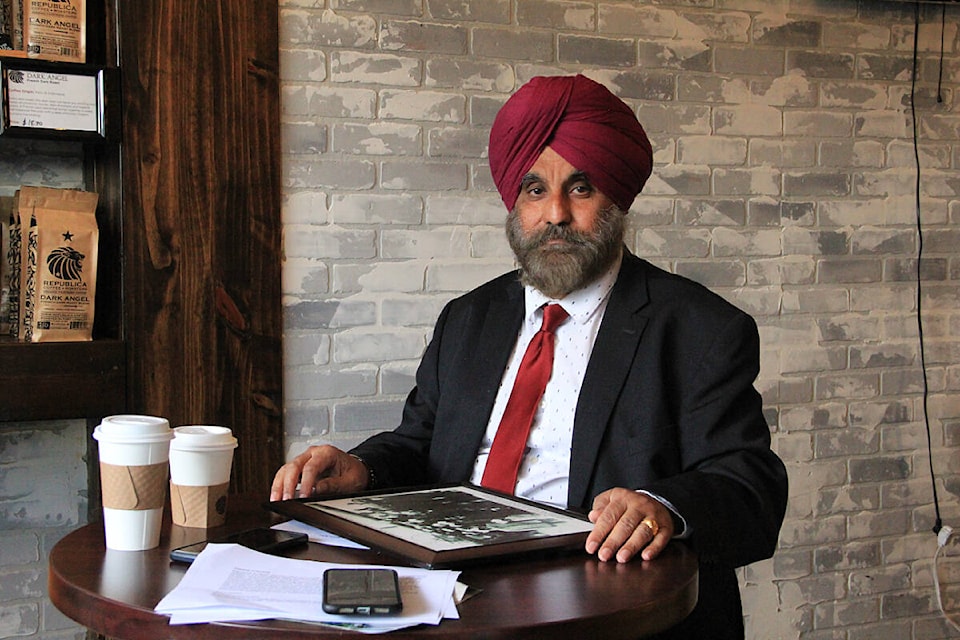Raj Singh Toor is a man on a mission.
The long-time Surrey resident had made it his life’s work to educate people about the Komagata Maru incident.
Toor’s connection to the tragic event is near to his heart: his grandfather was one of the would-be immigrants on the Komagata Maru in 1914 as it sailed into Burrard Inlet.
“My grandfather’s name was Puran Singh Janetpura,” said Toor. “He was a student at the time, but he got sent back. Only 27 were allowed to stay, because they were already living here, out of 376 passengers, but they were all British subjects.”
The SS Komagata Maru was involved in what is now known as the Komagata Maru incident. On May 23, 1914, the Japanese steamship Komagata Maru sailed into Vancouver carrying 376 South Asians who hoped to immigrate to Canada. They were all British subjects of Indian descent, including 340 Sikhs, 24 Muslims and 12 Hindus. Even though they were British subjects, they were denied entry. The ship was forced to leave and the prospective immigrants aboard had to return to India. Those onboard were also persecuted upon their return when they disembarked in Kolkata.
The incident was one of many during the early 1900s where specific exclusion laws in both the U.S. and Canada were used to bar people of Asian origin from immigrating to North America.
SEE ALSO: Model-maker Yvon Lehoux now working on a replica of Komagata Maru
When the ship was anchored off Vancouver, Toor said the authorities wouldn’t let the passengers disembark.
“My grandfather told me they could go three-four days without any food or water.”
He explained that the local South Asian community, numbering around 2,000 at the time, helped the passengers by fundraising so they could buy food and medicine for those onboard.
“They were drinking rainwater to survive.”
His grandfather told him of a child that became unconscious because of malnourishment.
“One of the passengers went to the cabin to find some water for the boy, but he only found a bottle of beer,” explained Toor. “So he slowly, slowly regained his consciousness with the beer. But when the captain came out, he started yelling. He didn’t care that a child was dying. He wanted his beer.”
Exactly two months later, the ship was forced to leave on July 23.
When the ship arrived in India, the passengers were treated harshly—some were even killed.
“The British were ruling India and when the Komagata Maru arrived, the British soldiers shot at the passengers,” said Toor. “Around 20 passengers were killed on the spot. Many were injured, and the rest of them were put in jail for a long period of time.”
Puran was arrested in Kolkata and spent five years in prison in Punjab.
After his grandfather got out in 1919, he was on a form of “town-arrest” and was not allowed to leave his village in Punjab.
Toor said most of the passengers joined the freedom movement to help win independence from British rule.
“The Komagata Maru incident was a very important event leading up to India’s independence in 1947,” said Toor.
Toor feels the incident is the spark that lit the fire of the Indian Independence movement—and it occurred a full five years before the Jallianwalla Bagh massacre of 1919, a watershed moment itself that galvanized the population toward fighting for the end of British rule in India.
“In fact, it was the first step in the independence movement,” he said. “It was a long fight, but they won.”
In 1962, Toor’s grandfather was recognized by the Indian government for his active role in the Indian freedom movement.
One of Puran Singh Janetpura’s sons (Toor’s uncle) sponsored Puran to come to Canada in 1968, but Puran turned it down.
“He said, ‘I will never go there because of the painful memories of Canada.’ But he was proud that he helped open the way there for other South Asians.”
Puran passed away in 1974, still living in his home village of Janetpura. In 1976 the Punjab government built a hospital in Janetpura and named it in his honour.
In 1983, Toor came to Canada as an 18-year-old with his family and he attended Lord Tweedsmuir for one year in Grade 12.
It wasn’t until years later, in 2006, that Toor searched for the families of Komagata Maru passengers. He found 15 families and together they formed the Descendants of the Komagata Maru Society. The society is “dedicated to educating people about the Komagata Maru Incident.”
Toor’s indefatigable fight to educate about the incident has won official apologies from all three levels of government. He has tirelessly worked to get municipalities to install storyboards or signs in several places across the Lower Mainland, including Surrey, Mission, Vancouver, Abbotsford, Port Moody, Richmond, Delta, and New Westminster.
Next up he’s targeting White Rock for some recognition, and he says things are currently in the works.
“The Komagata Maru passengers have a direct connection to White Rock,” said Toor. “Some Sikhs, the early pioneers, we’re living in White Rock in the summer of 1914. Some were working in the mill there,” Toor explained. “They helped the passengers with food, water, and medicine.”
For more info, visit descendantskomagatamaru.ca.
